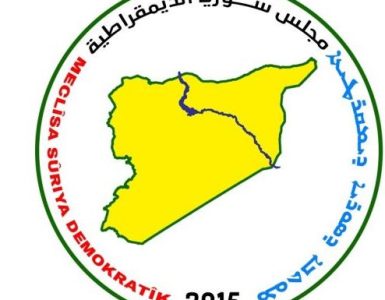By Waseem Al-Youssef
HASAKAH, Syria (SDC) – The situation in Syria following the fall of Bashar al-Assad’s regime might provide the Islamic State (ISIS) militants with an opportunity to exploit the chaos and regain lost territory.
In 2019, the Syrian Democratic Forces (SDF), supported by the Global Coalition, defeated ISIS in its last stronghold of Baghouz, eastern Syria.
Following this defeat, ISIS is now working to free its imprisoned militants, who are currently held captive in prisons controlled by the Autonomous Administration of North and East Syria (AANES). The recent announcement by the SDF about ISIS militants seizing control of certain areas in the Syrian Desert raises significant questions. It highlights the terrorist group’s ability to reorganize its ranks quickly and underscores the potential for ISIS to achieve territorial gains.
In a press conference held last Friday, Mazloum Abdi, Commander-in-Chief of the SDF, expressed deep concern over the escalating activities of ISIS militants in the Syrian Desert region, particularly in the southern and western areas of Deir ez-Zor and the countryside of Raqqa. Abdi attributed this resurgence to the recent developments in the region, including the withdrawal of the former Syrian regime forces, which has created a power vacuum exploited by ISIS.
“There is a critical need to safeguard the regions of Deir ez-Zor, Raqqa, and Tabqa from potential ISIS attacks. The SDF coordinate with the Global Coalition to counter the growing threat posed by ISIS remnants in the region,” Abdi emphasized.
Also: Kobani Faces New Turkish Threats
According to recent reports, the first half of 2024 witnessed a significant surge in terrorist activities by the ISIS in Syria. The group carried out approximately 473 attacks, representing a staggering 250% increase compared to the previous year. These attacks were primarily concentrated in the Deir ez-Zor, Raqqa, and Euphrates River Basin regions, with the latter recording 34 attacks within a seven-month period. However, the SDF in collaboration with the Global Coalition, successfully thwarted numerous ISIS attempts to attack mentioned regions.
In a notable development, the U.S. Central Command announced the execution of dozens of precision airstrikes targeting ISIS camps and high-value militants in central Syria on December 8, 2024. Over 75 targets were struck by utilizing B-52 bombers and F-15 fighter jets, with initial reports indicating no civilian casualties. The operations aim to prevent ISIS from conducting global terrorist activities and to ensure that the group cannot revive itself in central Syria.
During a Security Council session dedicated to the Syrian crisis, UN Special Envoy for Syria Geir Pedersen issued a stark warning, emphasizing the precarious and volatile nature of the situation. Pedersen highlighted the vast areas of Syria under the control of non-state actors such as armed groups, militias and local factions. He expressed concern over the potential resurgence of ISIS.
According to Agence France-Presse, the current situation in Syria provides favorable conditions for ISIS militants to grow. The country is plagued by uncertainty, ongoing conflicts, and power vacuum. Therefore, ISIS militants, operating in small slipper cells within the eastern Syrian Desert, are likely to exploit this instability. They will seek to capitalize on the challenging transitional phase following 13 years of the Syrian conflict.
Undoubtedly, chaos and instability would create a fertile ground for ISIS to exploit. The group, known for its ability to capitalize on instability, would seek to seize such opportunities to gradually re-establish its ranks across the country. Historically, ISIS has demonstrated a remarkable ability to capitalize on turmoil, waiting for the situation in Syria to deteriorate further. During times of instability, counter-ISIS forces like the SDF may become distracted, which provides ISIS with an opportunity to regroup and extend its influence.
ne of the most urgent and frequently mentioned concerns of the AANES is the presence of over 10,000 ISIS militants in its prisons. These individuals constitute a significant threat, with the potential to destabilize the region at any time.
Additionally, the threat includes the presence of approximately 60,000 people, including members of families and relatives of ISIS militants in displacement camps such as al-Hol and Roj, NE Syria. Consequently, any instability in the region could provide ISIS with an opportunity to attack these camps and prisons and free incarcerated terrorist individuals. This scenario played out in the past, with the SDF repeatedly thwarted extensive attacks by ISIS on detention facilities. The assault on Ghwayran prison in Hasakah in 2022 stands as a stark example of this threat.
Colin Clarke, Director of Research at the Soufan Center in New York, expressed concerns that the SDF may not be able to indefinitely secure detention facilities holding ISIS prisoners and their families. This is particularly true if the SDF face an attack by the Turkish military, which seeks to target areas under the control of the AANES.
Also: Suwayda Movement Continues to Concern Authorities in Damascus
Ultimately, the future situation hinges on the United States’ decision to keep its troops in Syria to fight ISIS and prevent Turkish aggression in areas controlled by the AANES.
During Donald Trump’s first term as President, his administration’s efforts to combat ISIS were significant and notable. So, even though his future plans are uncertain, the fight against ISIS is considered an important part of what he accomplished during his first term, according to Colin Clarke.
“The Trump administration aims to avoid taking actions that would undermine its primary objectives. Specifically, withdrawing U.S. forces from the region and allowing Turkey to carry out its operations without restrictions could strengthen ISIS. such a decision would be counterproductive to the administration’s efforts to combat ISIS,” Clarke stated.
It is worth noting that ISIS seized vast territories in Iraq and Syria in 2014, declared its so-called caliphate, and spread fear across the region and the world. By 2017, Iraq declared victory over ISIS with the support of the US-led Global Coalition.
Furthermore, the extremist group (ISIS) was defeated in Syria in 2019 by the SDF.




